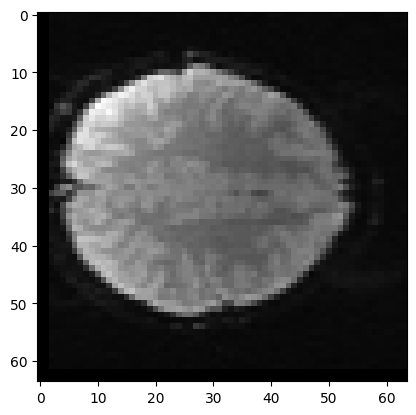Resampling with scipy.ndimage#
# import common modules
import numpy as np
np.set_printoptions(precision=4) # print arrays to 4DP
import matplotlib.pyplot as plt
plt.rcParams['image.cmap'] = 'gray'
Reampling, pull, push#
Let us say we have two images \(\mathbf{I}\) and \(\mathbf{J}\).
There is some spatial transform between them, such as a translation, or rotation.
We could either think of the transformation that maps \(\mathbf{I} \to \mathbf{J}\) or \(\mathbf{J} \to \mathbf{I}\).
The transformations map voxel coordinates in one image to coordinates in the other.
For example, write a coordinate in \(\mathbf{I}\) as \((x_i, y_i, z_i)\), and a coordinate in \(\mathbf{J}\) as \((x_j, y_j, z_j)\).
The mapping \(\mathbf{I} \to \mathbf{J}\) maps \((x_i, y_i, z_i) \to (x_j, y_j, z_j)\).
Now let us say that we want to move image \(\mathbf{J}\) to match image \(\mathbf{I}\).
To do this moving, we need to resample \(\mathbf{J}\) onto the same voxel grid as \(\mathbf{I}\).
Specifically, we are going to do the following:
make a new empty image \(\mathbf{K}\) that has the same voxel grid as \(\mathbf{I}\);
for each coordinate in \(\mathbf{I} : (x_i, y_i, z_i)\) we will apply the transform \(\mathbf{I} \to \mathbf{J}\) to get \((x_j, y_j, z_j)\);
we will probably need to estimate a value \(v\) from \(\mathbf{J}\) at \((x_j, y_j, z_j)\) because the coordinate values \((x_j, y_j, z_j)\) will probably not be integers, and so there is no exactly matching value in \(\mathbf{J}\);
we place \(v\) into \(\mathbf{K}\) at coordinate \((x_i, y_i, z_i)\).
Notice that, in order to move \(\mathbf{J}\) to match \(\mathbf{I}\) we needed the opposite transform – that is: \(\mathbf{I} \to \mathbf{J}\). This is called pull resampling.
We will call the \(\mathbf{I} \to \mathbf{J}\) transform the resampling transform.
Scipy ndimage and affine_transform#
Scipy has a function for doing reampling with transformations, called scipy.ndimage.affine_transform.
from scipy.ndimage import affine_transform
It does all the heavy work of resampling for us.
For example, lets say we have an image volume \(\mathbf{I}\)
(ds107_sub012_t1r2.nii):
# Fetch the data file.
import nipraxis
# Fetch image file.
bold_fname = nipraxis.fetch_file('ds107_sub012_t1r2.nii')
bold_fname
'/home/runner/.cache/nipraxis/0.5/ds107_sub012_t1r2.nii'
import nibabel as nib
img = nib.load(bold_fname)
data = img.get_fdata()
I = data[..., 0] # I is the first volume
We have another image volume \(\mathbf{J}\):
J = data[..., 1] # I is the second volume
Let’s say we know that the resampling transformation \(\mathbf{I} \to \mathbf{J}\) is given by:
a rotation by 0.2 radians about the x axis;
a translation of [1, 2, 3] voxels.
See Rotations and rotation matrices for more on 2D and 3D rotation matrices.
Here we use the nipraxis.rotations module. It has routines that will make 3 by 3 rotation matrices for rotations by given angles around the x, y, and z axes.
Of course you will want to be assured these functions are tested. Have a look at test_rotations.py.
We use the routines in the nipraxis.rotations module to make the rotation
matrix we need:
from nipraxis.rotations import x_rotmat
# rotation matrix for rotation of 0.2 radians around x axis
M = x_rotmat(0.2)
M
translation = [1, 2, 3] # Translation from I to J
translation
[1, 2, 3]
The affine_transform function does the work of resampling. By default, it
implements the following algorithm:
makes the new empty volume
K, assuming it will be the same shape asJ;for each coordinate \((x_i, y_i, z_i)\) implied by the volume
K:apply the transformations implied by
Mandtranslationto \((x_i, y_i, z_i)\) to get the corresponding point inJ: \((x_j, y_j, z_j)\);resample
Jat \((x_j, y_j, z_j)\) to get \(v\);place \(v\) at \((x_i, y_i, z_i)\) in
K
# order=1 for linear interpolation
K = affine_transform(J, M, translation, order=1)
K.shape
plt.imshow(K[:, :, 17])
<matplotlib.image.AxesImage at 0x7fda29b70be0>

Resampling with images of different shapes#
Notice the assumption that affine_transform makes above – that the
output image will be the same shape as the input image.
This need not be the case. In fact we can tell affine_transform to start
with an empty volume K with another shape. To do this, we use the
output_shape parameter.
Now we can be more precise about the algorithm of affine_transform.
affine_transform accepts:
input– an array to resample from. Say this array asndimensions (len(input.shape));matrix– annbyntransformation matrix (the top leftmatpart of an affine);offset– a optional lengthntranslation vector to be applied after thematrixtransformation (thevecpart of an affine);output_shape: an optional tuple giving the shape of the output array into which we will put the values resampled frominput.output_shapedefaults toinput.shape; this is the default we have been using above.
affine_transform then generates all the voxel coordinates implied by the
output_shape, and transforms them with the matrix and offset
transforms to get a new set of coordinates C. It then samples the
input array at the coordinates given by C to generate the output
array.
Here is the call to affine_transform that we used above, where we allowed
the routine to assume that the output shape was the same as the input shape:
K = affine_transform(J, M, translation, order=1)
K.shape
(64, 64, 35)
The is the same as the following call, where we specify the shape explicitly:
K = affine_transform(J, M, translation, output_shape=J.shape, order=1)
K.shape
(64, 64, 35)
The output shape can be different from the input shape:
K = affine_transform(J, M, translation,
output_shape=(65, 65, 36), order=1)
K.shape
(65, 65, 36)
Remember that the M matrix and translation vector apply to the
coordinates implied by the output shape.



